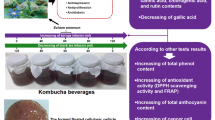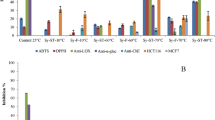Abstract
Considering the enological interest of cork, this study aimed to identify and quantify the phenolic compounds able to migrate from different classes (natural cork stoppers “Flor” and “Third” quality and microagglomerate cork stopper) of cork stoppers into bottled wine model solutions. Another aim was to evaluate some antioxidant and biological features of cork phenolics that migrated into the wine model solutions. The main phenolic acids and aldehydes detected were as follows: gallic and protocatechuic acid detected both around 3.5 mg/L and vanillin and protocatechuic aldehyde detected around 2.5 and 1.5 mg/L after 27 months of bottling, respectively. Trace amounts of more complex polyphenols, namely hydrolysable tannins (castalagin/vescalagin and mongolicain A/B), were also detected. Two antioxidant features of the wine model solutions bottled with different wine cork stoppers were studied, namely the antiradical capacity and the reducing capacity, being the natural cork stoppers the ones with the higher activities. The intestinal absorption of the compounds in each wine model solution after 27 months in bottled was evaluated. The simpler phenolic compounds were able to cross Caco-2 cell model. The antiproliferative activity of the same wine model solutions was also evaluated against gastric and breast cancer cells. All samples were active against the two cell lines, which highlight the possible health outcomes of wine sealed with cork stoppers.




Similar content being viewed by others
References
Casey J (1994) Is cork a good seal for wine? Aust Grapegrow Winemak 372:39–41
Jung R, Hamatscheck J (1992) Structure and characteristics of natural cork in relation to its use as closure material for bottles. Wein-Wiss 47:226–234
Oliveira V, Knapic S, Pereira H (2013) Classification modeling based on surface porosity for the grading of natural cork stoppers for quality wines. Food Bioprod Process. doi:10.1016/j.fbp.2013.11.004
Gonzalez-Adrados JR, Pereira H (1996) Classification of defects in cork planks using image analysis. Wood Sci Technol 30(3):207–215
Pereira H, Lopes F, Graça J (1996) The evaluation of the quality of cork planks by image analysis. Holzforschung 50(2):111–115
Oliveira V, Knapic S, Pereira H (2012) Natural variability of surface porosity of wine cork stoppers of different commercial classes. J Int des Sci de la Vigne et du Vin 46(4):331–340
Karbowiak T, Gougeon RD, Alinc JB, Brachais L, Debeaufort F, Voilley A, Chassagne D (2010) Wine oxidation and the role of cork. Crit Rev Food Sci Nutr 50(1):20–52. doi:10.1080/10408390802248585
Pereira H (1988) Chemical composition and variability of cork from Quercus suber L. Wood Sci Technol 22(3):211–218
Rocha SM, Ganito S, Barros A, Carapuça HM, Delgadillo I (2005) Study of cork (from Quercus suber L.)-wine model interactions based on voltammetric multivariate analysis. Anal Chim Acta 528(2):147–156
Varea S, Garcia-Vallejo MC, Cadahia E, de Simon BF (2001) Polyphenols susceptible to migrate from cork stoppers to wine. Eur Food Res Technol 213(1):56–61
Schwarz M, Jerz G, Winterhalter P (2003) Isolation and structure of Pinotin A, a new anthocyanin derivative from Pinotage wine. Vitis 42(2):105–106
Oliveira J, de Freitas V, Silva AMS, Mateus N (2007) Reaction between hydroxycinnamic acids and anthocyanin-pyruvic acid adducts yielding new portisins. J Agric Food Chem 55(15):6349–6356. doi:10.1021/jf070968f
Marin AB, Jorgensen EM, Kennedy JA, Ferrier J (2007) Effects of bottle closure type on consumer perceptions of wine quality. Am J Enol Vitic 58(2):182–191
Fernandes A, Fernandes I, Cruz L, Mateus N, Cabral M, de Freitas V (2009) Antioxidant and biological properties of bioactive phenolic compounds from Quercus suber L. J Agric Food Chem 57(23):11154–11160. doi:10.1021/jf902093m
Azevedo J, Fernandes I, Faria A, Oliveira J, Fernandes A, de Freitas V, Mateus N (2009) Antioxidant properties of anthocyanidins, anthocyanidin-3-glucosides and respective portisins. Food Chem 119(2):518–523. doi:10.1016/j.foodchem.2009.06.050
Benzie IF, Strain JJ (1996) The ferric reducing ability of plasma (FRAP) as a measure of “antioxidant power”: the FRAP assay. Anal Biochem 239(1):70–76
Fernandes I, Faria A, Azevedo J, Soares S, Calhau C, de Freitas V, Mateus N (2010) Influence of anthocyanins, derivative pigments and other catechol and pyrogallol-type phenolics on breast cancer cell proliferation. J Agric Food Chem 58(6):3785–3792. doi:10.1021/jf903714z
Sefton MA, Simpson RF (2005) Compounds causing cork taint and the factors affecting their transfer from natural cork closures to wine–a review. Aust J Grape Wine Res 11(2):226–240. doi:10.1111/j.1755-0238.2005.tb00290.x
Fernandes A, Sousa A, Mateus N, Cabral M, de Freitas V (2011) Analysis of phenolic compounds in cork from Quercus suber L. by HPLC–DAD/ESI–MS. Food Chem 125(4):1398–1405. doi:10.1016/j.foodchem.2010.10.016
Manach C, Williamson G, Morand C, Scalbert A, Rémésy C (2005) Bioavailability and bioefficacy of polyphenols in humans. I. Review of 97 bioavailability studies. Am J Clin Nutr 81(1):230S–242S
Williamson G, Clifford M (2010) Colonic metabolites of berry polyphenols: the missing link to biological activity? Br J Nutr 104:S48–S66. doi:10.1017/S0007114510003946
Kroon PA, Clifford MN, Crozier A, Day AJ, Donovan JL, Manach C, Williamson G (2004) How should we assess the effects of exposure to dietary polyphenols in vitro? Am J Clin Nutr 80(1):15–21
Acknowledgments
This work was supported by FCT (Fundação para a Ciência e Tecnologia) (POCI, FEDER, POPH, QREN) by the studentship grant (SFRH/BPD/86173/2012). The authors also want to thank BIOCORK Project no. 11430 for the financial support.
Conflict of interest
None.
Compliance with Ethics Requirements
This article does not contain any studies with human or animal subjects.
Author information
Authors and Affiliations
Corresponding author
Rights and permissions
About this article
Cite this article
Azevedo, J., Fernandes, I., Lopes, P. et al. Migration of phenolic compounds from different cork stoppers to wine model solutions: antioxidant and biological relevance. Eur Food Res Technol 239, 951–960 (2014). https://doi.org/10.1007/s00217-014-2292-y
Received:
Accepted:
Published:
Issue Date:
DOI: https://doi.org/10.1007/s00217-014-2292-y




